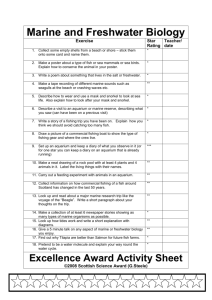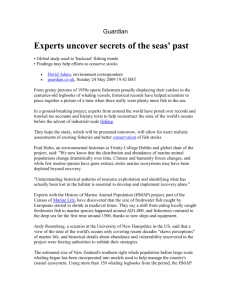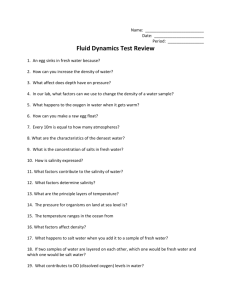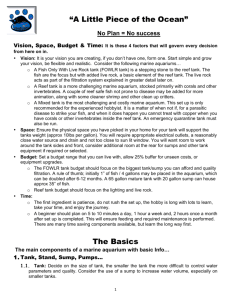KEEPING SALT WATER FISH - Aqua Life Warrnambool Aquarium
advertisement
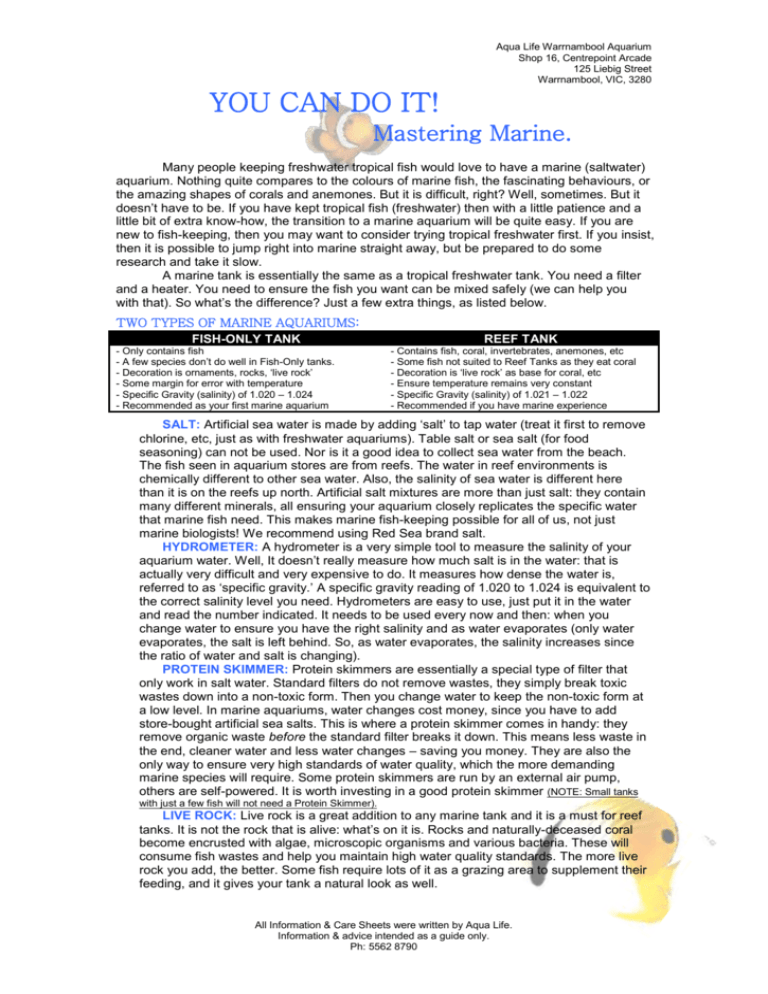
Aqua Life Warrnambool Aquarium Shop 16, Centrepoint Arcade 125 Liebig Street Warrnambool, VIC, 3280 YOU CAN DO IT! Mastering Marine. Many people keeping freshwater tropical fish would love to have a marine (saltwater) aquarium. Nothing quite compares to the colours of marine fish, the fascinating behaviours, or the amazing shapes of corals and anemones. But it is difficult, right? Well, sometimes. But it doesn’t have to be. If you have kept tropical fish (freshwater) then with a little patience and a little bit of extra know-how, the transition to a marine aquarium will be quite easy. If you are new to fish-keeping, then you may want to consider trying tropical freshwater first. If you insist, then it is possible to jump right into marine straight away, but be prepared to do some research and take it slow. A marine tank is essentially the same as a tropical freshwater tank. You need a filter and a heater. You need to ensure the fish you want can be mixed safely (we can help you with that). So what’s the difference? Just a few extra things, as listed below. TWO TYPES OF MARINE AQUARIUMS: FISH-ONLY TANK - Only contains fish - A few species don’t do well in Fish-Only tanks. - Decoration is ornaments, rocks, ‘live rock’ - Some margin for error with temperature - Specific Gravity (salinity) of 1.020 – 1.024 - Recommended as your first marine aquarium REEF TANK - Contains fish, coral, invertebrates, anemones, etc - Some fish not suited to Reef Tanks as they eat coral - Decoration is ‘live rock’ as base for coral, etc - Ensure temperature remains very constant - Specific Gravity (salinity) of 1.021 – 1.022 - Recommended if you have marine experience SALT: Artificial sea water is made by adding ‘salt’ to tap water (treat it first to remove chlorine, etc, just as with freshwater aquariums). Table salt or sea salt (for food seasoning) can not be used. Nor is it a good idea to collect sea water from the beach. The fish seen in aquarium stores are from reefs. The water in reef environments is chemically different to other sea water. Also, the salinity of sea water is different here than it is on the reefs up north. Artificial salt mixtures are more than just salt: they contain many different minerals, all ensuring your aquarium closely replicates the specific water that marine fish need. This makes marine fish-keeping possible for all of us, not just marine biologists! We recommend using Red Sea brand salt. HYDROMETER: A hydrometer is a very simple tool to measure the salinity of your aquarium water. Well, It doesn’t really measure how much salt is in the water: that is actually very difficult and very expensive to do. It measures how dense the water is, referred to as ‘specific gravity.’ A specific gravity reading of 1.020 to 1.024 is equivalent to the correct salinity level you need. Hydrometers are easy to use, just put it in the water and read the number indicated. It needs to be used every now and then: when you change water to ensure you have the right salinity and as water evaporates (only water evaporates, the salt is left behind. So, as water evaporates, the salinity increases since the ratio of water and salt is changing). PROTEIN SKIMMER: Protein skimmers are essentially a special type of filter that only work in salt water. Standard filters do not remove wastes, they simply break toxic wastes down into a non-toxic form. Then you change water to keep the non-toxic form at a low level. In marine aquariums, water changes cost money, since you have to add store-bought artificial sea salts. This is where a protein skimmer comes in handy: they remove organic waste before the standard filter breaks it down. This means less waste in the end, cleaner water and less water changes – saving you money. They are also the only way to ensure very high standards of water quality, which the more demanding marine species will require. Some protein skimmers are run by an external air pump, others are self-powered. It is worth investing in a good protein skimmer (NOTE: Small tanks with just a few fish will not need a Protein Skimmer). LIVE ROCK: Live rock is a great addition to any marine tank and it is a must for reef tanks. It is not the rock that is alive: what’s on it is. Rocks and naturally-deceased coral become encrusted with algae, microscopic organisms and various bacteria. These will consume fish wastes and help you maintain high water quality standards. The more live rock you add, the better. Some fish require lots of it as a grazing area to supplement their feeding, and it gives your tank a natural look as well. All Information & Care Sheets were written by Aqua Life. Information & advice intended as a guide only. Ph: 5562 8790
